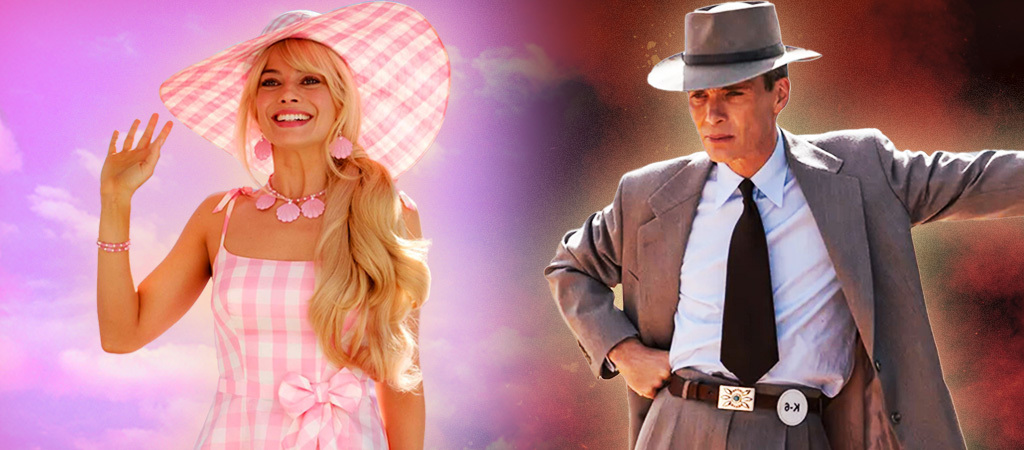
Barbenheimer went from a meme to a movement to a celebration of movies with the power of 1,000 Nicole Kidman AMC ads. In a world painted gray by the overuse of phrases like iconic, culture-defining, and earth-shaking, this phenomenon was actually all of the above. And it got that money, too. But will Barbenheimer’s success be studied like a new playbook or shaken off as a once-in-a-blue-moon perfect storm?
Let me start by saying I don’t participate in box office discourse, I endure it. Quickly assigning badges like “blockbuster” and “bomb” makes movies less accessible by telling an incomplete story about their actual quality. It also taints the overall conversation as debates over art and meaning give way to talk about franchise viability.
Some fans pay so much attention to box office returns that you’d think they’re getting points on the backend. It weirds me out. But Barbie and Oppenheimer combining to make approximately $240M through their opening weekend in the US (over $400 million worldwide) is undeniably interesting and worth comment. Especially when compared to the rather middling performances of this summer’s most anticipated tentpoles – The Flash, Indiana Jones And The Dial Of Destiny, and Mission Impossible Dead Reckoning Part 1.
Those films collectively, represent a popular path that’s all about an assumption (somewhat undone by Barbenheimer) that there is only safety in franchises and in what is known, such as the 5th Indiana Jones, the 7th Mission Impossible, and the umpteenth DCEU movie. (I could have gone back and counted, but haven’t those films taken enough of my time?)
This is also why we get so many Marvel and Star Wars shows and movies every year: familiarity, but it’s starting to come at a risk. Like, people still get up for these projects, but the excitement and cultural conversation dominance are palpably lighter. The whys are myriad and subjective, but one thing is, as a Marvel and Star Wars fan, I might need to track 40-50 hours of entertainment each year to stay engaged with those two separate worlds. This is at a time when it feels like other “prestige” shows are cutting their episode counts or ending altogether after shorter-than-typical runs. Comparatively, Marvel and Star Wars fandom can feel like an obligation. A fun one, often, but an obligation all the same.
I think studios sense this. Despite critical hyperbole, they aren’t actually churning out carbon copies, it’s more like variations on the same. Big, explosive, CGI-powered variations on the same that expand ideas. It’s simple Hollywood math: the sequel to the sequel’s sequel must be 4X bigger than the original or what are we even doing here and why are we spending $400 million and don’t we have to spend that if we want to make a billion and don’t we HAVE to make a billion? It’s kind of desensitizing and it’s definitely exhausting.
It’s not that people don’t want to see familiar characters in slightly remixed scenarios, it’s that the urgency might just be capped because of the sheer volume of prompts every year to do exactly that with another familiar franchise. You can’t feel FOMO when it’s all a bit “been there done that.”
A movie about a doll with fading relevancy and a 3-hour historical epic about a weapon to end a war waged by our grandparents and great-grandparents. By those descriptions, Barbie and Oppenheimer weren’t supposed to capture broad audiences and crush at the box office. And yet.
It was almost immediately clear from the first images and footage that these films would be ambitious, specific, smart, well-acted, and the product of letting two tremendous filmmakers (Greta Gerwig and Christopher Nolan) cook. Barbie and Oppenheimer were fresh and unlike other things on the summer slate, and so originality and the promise of a good time became their own kind of must-see spectacle. Still, no one predicted the two films would combine to break records and unify fans, creating a celebratory moment of culture and commerce that we have rarely seen.
I’m sure, in some circles, this is all a little terrifying. A lot of people in the entertainment industry justify their existence by knowing the future before it happens when it comes to what audiences will and won’t gravitate toward. But this is why we play the game, and now we have new data that, hopefully, points toward betting on creative vision more and maybe letting off the gas a little when it comes to franchise golden geese before exhaustion settles in.
The audience is out there, money in hand, begging for more (that doesn’t necessarily mean Barbie 2 or the Adventures Of Young Oppenheimer). We’re ready to embrace more unicorn films like Barbie and Oppenheimer (and They Cloned Tyrone, which was the #1 streamed film on Netflix this weekend and an utterly fantastic, imaginative, and clever sci-fi social satire). Evidence is mounting that we’re verifiably less inclined to care about paint-by-numbers products pumped out by computers (or unambitious humans) that just repurpose and re-order pre-existing words and ideas, rarely challenging or respecting us.
Studios should remember all of this, especially in this tense moment as they consider the impact of the ongoing stalemate with the writers and actors that is, at least in part, about leaning into AI tech that would create that kind of cookie-cutter content. The resulting rationing of films and scuttling of positive momentum for the industry does not one any good in the short or long term. Because it’s not just about lost dollars, it’s about lost relevancy and enthusiasm, which are harder to recover.
Can you remember the last time there was this much excitement and joy about movies? It’s like there’s a shady figure just out of view sneaking up on all of us to drag us back down to the dregs of empty theaters and boring weekends. I hope someone does something about it. If we avoid calamity, we may have Barbenheimer to thank.
